originally published on It’s Going Down
With insurrections against fare increases and austerity still raging across the world, a call on November 29th for a fare strike and actions demanding free and increased transit access, along with police and fare inspectors to be removed from buses and trains, has generated increasing attention. In Seattle, growing controversy over the anarchist initiated call for a fare strike has even pushed the local alt-weekly, The Stranger, to publish two editorials on the action, including one supportive piece entitled, “A Fare Strike is a Good Idea.”
Regardless of what goes down on the 29th, across the US, the intersections of mass transit, the rising cost of living, surveillance and policing, and gentrification and housing – are already inspiring revolt. Over the past few weeks in New York, thousands have taken to the streets to engage in mass fare evasion, clashing with police, and even sabotaging turnstiles. These actions were in part inspired by the ongoing insurrection in Chile, which was ignited by youth organizing mass fare evasions. Meanwhile, on Staten Island, Amazon workers are protesting to guarantee free transit to and from work, among other demands around conditions and break times.
Wanting to know more about what’s pushing the actions in Seattle on the 29th, we caught up with some anarchists who are participating in the upcoming fare strike to learn more.
IGD: Give us an over view of what is happening on the 29th. Is it just going down in Seattle?
The call that came from Seattle for the 29th has grown beyond anyone’s expectations. The nature of the call makes it difficult to pinpoint exactly how many cities will be participating, but there are events called for Seattle, San Fransisco, Portland, Chicago, and Toronto – that we know of. Endorsements have come internationally from Sweden and Chile. There is a lot of talk online of more cities potentially participating: NYC, Vancouver, Helsinki and Santiago. Suffice to say, if you refuse to pay your fare that day, you won’t be alone! Watch @NobodyPays on Twitter for updates and news.
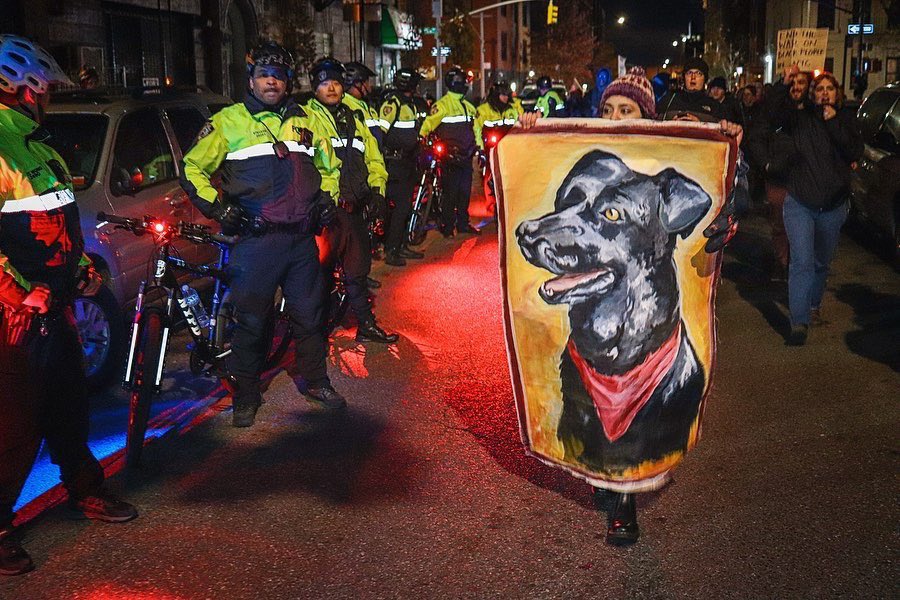
We hope that more cities and towns respond, adopting this tactic to suit their context. For some bigger cities, like Seattle and NYC, that might mean a demo and collective fare evasion. In smaller places, that might be a leafleting campaign outside a transit hub or putting up posters in support of the day. Regardless of scale, our hope is that people are able to use this call to find each other; to find creative ways to fight back against the rising cost of living in their respective homes.
IGD: What is the goal of the fare strike?
The goal of the strike is as diverse as the participants choose to make it. The absence of a list of “demands” is intentional. The squeeze all of us are feeling and the ways in which life have become impossibly costly are diverse and complicated. Just the same, our responses to it will be diverse and contextual. Freedom of movement through unhindered access to mass transit is clearly at the center of this call. Included in that is the right to travel without fear of the police or surveillance. But at the same time, the expansion and maintenance of mass transit infrastructure is interwoven with the pattern of gentrification, displacement, and increased policing seen in most medium and large cities. There is no such thing as a little bit of freedom and there’s no ideal place to start in the fight to reclaim our cities. So we’re starting here.
“This is not a moment where we are speaking truth to a power that we know refuses to listen, but showing some collective muscle at our ability to withdraw our participation as well as strike back.”
When this most recent wave of strikes first began, we wanted to show the world that we stood with them – that their fight is our fight. We wanted to address not only the increasing immiseration of our lives here in the States, but also show solidarity with those fighting elsewhere.
IGD: Where did the idea for the 29th come from?
Anarchists in the US, and everyone really, have been watching for months as pitched battles against austerity, the state and the remnants of neoliberal policies have become literal life or death moments. The list of cities that are experiencing some kind of insurgency or vibrant mass movement grows daily. Alarmingly, reaction in each of these places is quickly consolidating – a short list includes: the evangelical/anti-indigenous coup in Bolivia, the far-Right surges of the VOX party in Spain and other European parliamentary groups, and the looming possibility of continued white nationalist violence in the coming US presidential election. It’s evident that we are in a very important global moment and in turn, international solidarity has become very important.
November 29th is the day after the day we celebrate the totalizing genocide of people indigenous on Turtle Island. November 29th is Black Friday, a day of mass consumption run rampant in the midst of the growing ecological catastrophe. It was not too far in the future and just far away enough that we could build a mobilization around. We chose it, quite frankly, because unless you’re from affluence – it is really the worst fucking day. Its a day that we would love to disrupt with massive fare evasions – to force a reprioritization on the issues and conflicts that actually matter.
IGD: How can people participate on the 29th?
The original call is very open ended on purpose. So far, several groups have called for specific actions on the 29th. There is a meet-up in Seattle @ noon at the Mt. Baker Lightrail station, in Portland @Pioneer Sq, and a call from SF for 16th and Mission. Besides these, participation can take any other number of forms. Refuse to pay that day and ride transit, you can hand out flyers to other transit riders about why they should refuse, you can cover your bus route in fare strike graffiti or sabotage the machines so #nobodypays.
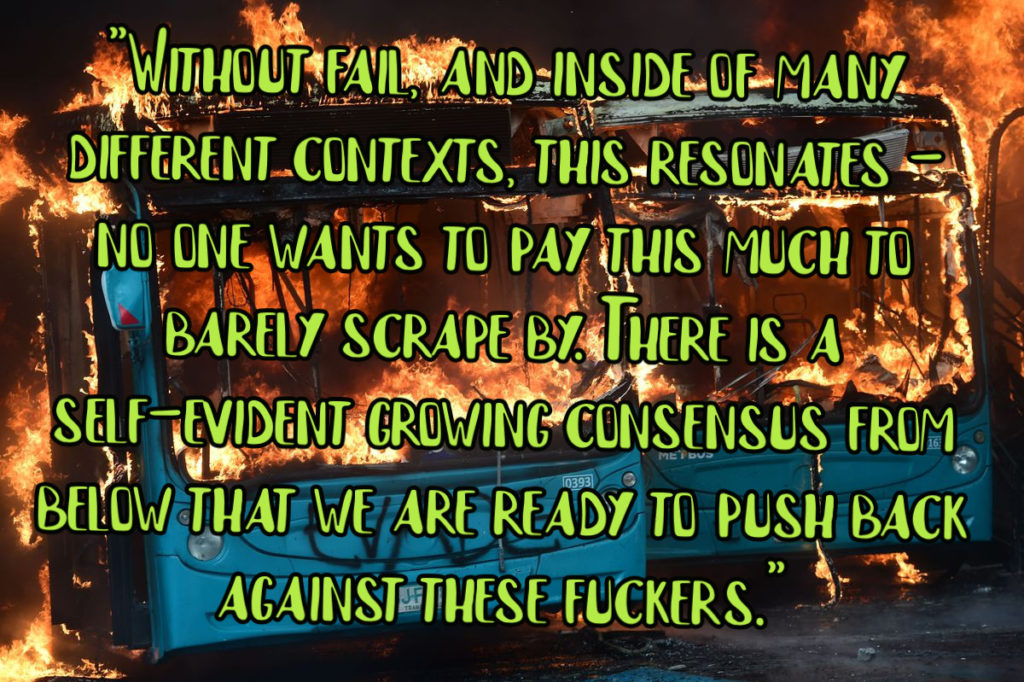
The options are limitless – this is a fight for liberation from a system that is literally squeezing the life out of us – all those wishing to see a world free of domination and hierarchy are encouraged to jump in where they can. And while this was announced by anarchists first, we recognize that the fight is broad and collective. We hope many different people will find resonance with the day.
IGD: Has the fare strike garnered interest or feedback already? What are people saying?
The initial response to the fare strike was overwhelming, and greatly exceeded what we expected. This really resonated with people. And not just here in the Pacific Northwest, but across the country and the world. It speaks to a thing that we are all feeling, that life is getting harder and the structures trying to keep us down are becoming more formidable. The reactionary Right is gaining momentum in many parts of the world. In some places that resembles a rise to political power and in some places it is literally the institutions of fares and tariffs that criminalize poverty. Without fail, and inside of many different contexts, this resonates – no one wants to pay this much to barely scrape by. There is a self-evident growing social consensus from below that we are ready to push back against these fuckers.
IGD: Everywhere things are getting worse as the cost of living goes up. What role does mass transit play?
In all the major cities of the world the working poor use transit to get themselves to and from work. Whether its NYC, London, CDMX or Santiago, everyone is familiar with the grind. In some cities, this commute swallows an enormous percentage of our wages and our time. We pay a lot of money just to be subjected to aggressive police, private security, and watchful cameras, everywhere. It’s absurd that we are expected to pay for this crap and even more absurd that we can be fined or sent to jail for evading fare. Conversely, in a lot of more rural places, the same transportation expectations are there, with none of the infrastructure – people might have to walk miles to get work each day. The bus lines in the hood, the rural para-transit, and the subsidies for poor youths are the first things that get cut, while transit that moves rich people to and from their homes gets more and more funding.
“In a lot of more rural places, the same transportation expectations are there, with none of the infrastructure – people might have to walk miles to get work each day. The bus lines in the hood, the rural para-transit, and the subsidies for poor youths are the first things that get cut, while transit that moves rich people to and from their homes gets more and more funding.”
In Seattle, we see a direct correlation between the light rail and wholesale gentrification. Everywhere they built a station, luxury apartments and bourgeois boutiques followed. They are connecting the richest parts of the region while bisecting historically impoverished south-end neighborhoods by running the train above ground. On top of that, if you are Black or Brown you are much more likely to end up inside the criminal justice system if you step foot on a train or a bus. It is incredibly clear that none of this infrastructure was built for us. Seattle is just an example, but we can see in places like Chile and Mexico where fare increases are quickly outpacing the ability of many regular people to pay. People are being forced into the impossible situation of having work they can’t afford to get to, it’s a bankruptcy of policy and the quality of life we all deserve.
IGD: For those that want to take part in the transit strike but maybe are scared because this seems much different than say, the Climate Strike, what advice would you give them?
One of the phrases that has been splashed across walls in Chile and the Spanish speaking world is “No tenemos miedo,” meaning: “We are not afraid.” Fear is a real part of engaging in any kind of social movement, no matter how conflictual it is. There are a lot of forces out there that would see us broken – but this phrase “we are not afraid” is important in that it speaks to us collectively. We are in fact very strong when we act together and in solidarity with one another.
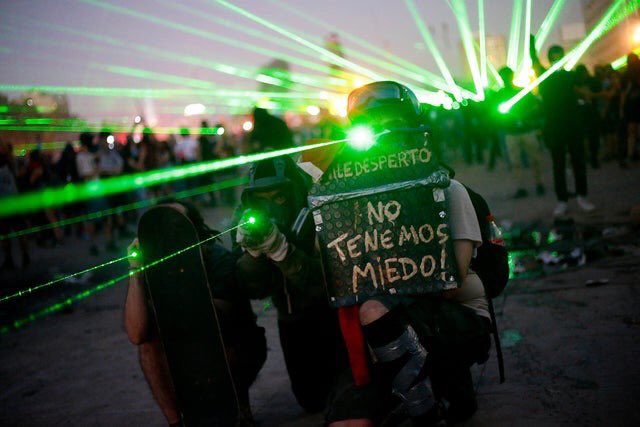
Events like the climate strike, while conflictual in some places (looking at you Portland), were larger events without much direction or a focus of activity. Which does not detract from their importance, but situates them as something different than this fare strike. This is not a moment where we are speaking truth to a power that we know refuses to listen, but showing some collective muscle at our ability to withdraw our participation as well as strike back. So the best advice we can give is to find others that you wish to share this struggle with, and do what fits your capacity and your abilities best. If that means you can’t participate in the direct strike but you can help fundraise for those that have fines later, that’s still being a part of this strike. Be creative in the ways that you want to engage and take care of each other, things may appear scary when we are all alone-but when we do find each other- we have no need to be afraid.
IGD: Where can people go to get more information?
Crimethinc.com has been posting updates about the very global nature of this day and reposting the calls and responses from various countries and cities. Twitter.com/nobodypays has been acting as a clearing house for information but is PNW centered. Twitter.com/decolonize_this has been holding it down with updates on the east coast of the US. And IGD is always good with the reportbacks and roundups.
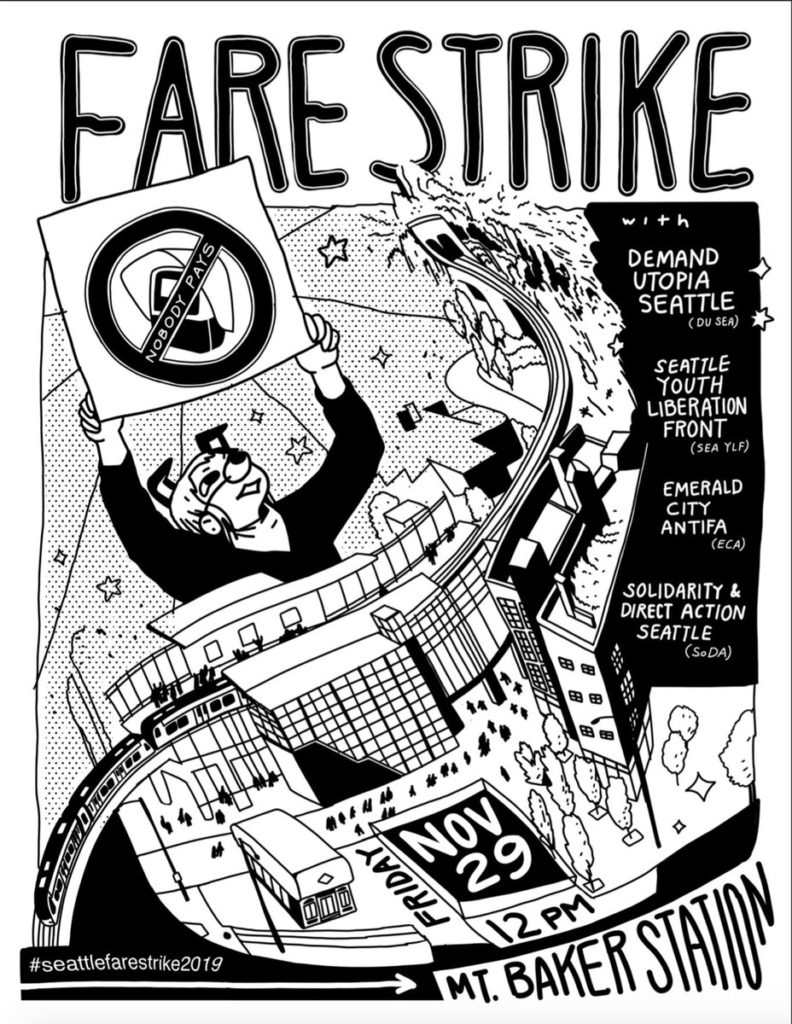
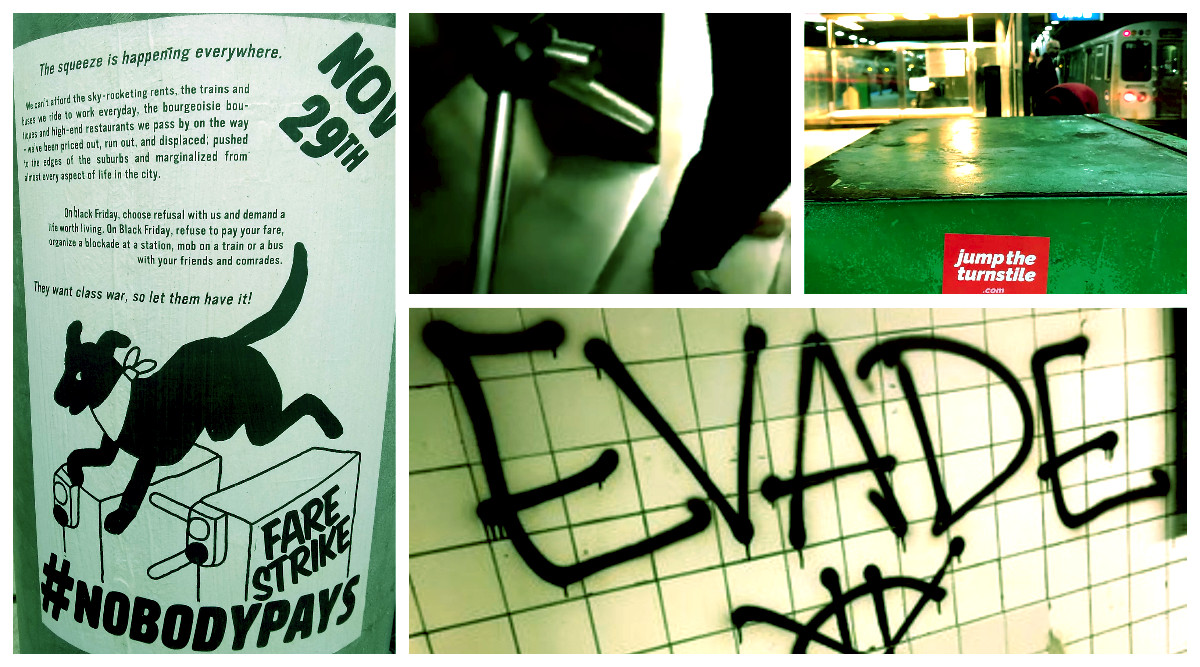


originally published on It’s Going Down
With insurrections against fare increases and austerity still raging across the world, a call on November 29th for a fare strike and actions demanding free and increased transit access, along with police and fare inspectors to be removed from buses and trains, has generated increasing attention. In Seattle, growing controversy over the anarchist initiated call for a fare strike has even pushed the local alt-weekly, The Stranger, to publish two editorials on the action, including one supportive piece entitled, “A Fare Strike is a Good Idea.”
Regardless of what goes down on the 29th, across the US, the intersections of mass transit, the rising cost of living, surveillance and policing, and gentrification and housing – are already inspiring revolt. Over the past few weeks in New York, thousands have taken to the streets to engage in mass fare evasion, clashing with police, and even sabotaging turnstiles. These actions were in part inspired by the ongoing insurrection in Chile, which was ignited by youth organizing mass fare evasions. Meanwhile, on Staten Island, Amazon workers are protesting to guarantee free transit to and from work, among other demands around conditions and break times.
Wanting to know more about what’s pushing the actions in Seattle on the 29th, we caught up with some anarchists who are participating in the upcoming fare strike to learn more.
IGD: Give us an over view of what is happening on the 29th. Is it just going down in Seattle?
The call that came from Seattle for the 29th has grown beyond anyone’s expectations. The nature of the call makes it difficult to pinpoint exactly how many cities will be participating, but there are events called for Seattle, San Fransisco, Portland, Chicago, and Toronto – that we know of. Endorsements have come internationally from Sweden and Chile. There is a lot of talk online of more cities potentially participating: NYC, Vancouver, Helsinki and Santiago. Suffice to say, if you refuse to pay your fare that day, you won’t be alone! Watch @NobodyPays on Twitter for updates and news.
We hope that more cities and towns respond, adopting this tactic to suit their context. For some bigger cities, like Seattle and NYC, that might mean a demo and collective fare evasion. In smaller places, that might be a leafleting campaign outside a transit hub or putting up posters in support of the day. Regardless of scale, our hope is that people are able to use this call to find each other; to find creative ways to fight back against the rising cost of living in their respective homes.
IGD: What is the goal of the fare strike?
The goal of the strike is as diverse as the participants choose to make it. The absence of a list of “demands” is intentional. The squeeze all of us are feeling and the ways in which life have become impossibly costly are diverse and complicated. Just the same, our responses to it will be diverse and contextual. Freedom of movement through unhindered access to mass transit is clearly at the center of this call. Included in that is the right to travel without fear of the police or surveillance. But at the same time, the expansion and maintenance of mass transit infrastructure is interwoven with the pattern of gentrification, displacement, and increased policing seen in most medium and large cities. There is no such thing as a little bit of freedom and there’s no ideal place to start in the fight to reclaim our cities. So we’re starting here.
When this most recent wave of strikes first began, we wanted to show the world that we stood with them – that their fight is our fight. We wanted to address not only the increasing immiseration of our lives here in the States, but also show solidarity with those fighting elsewhere.
IGD: Where did the idea for the 29th come from?
Anarchists in the US, and everyone really, have been watching for months as pitched battles against austerity, the state and the remnants of neoliberal policies have become literal life or death moments. The list of cities that are experiencing some kind of insurgency or vibrant mass movement grows daily. Alarmingly, reaction in each of these places is quickly consolidating – a short list includes: the evangelical/anti-indigenous coup in Bolivia, the far-Right surges of the VOX party in Spain and other European parliamentary groups, and the looming possibility of continued white nationalist violence in the coming US presidential election. It’s evident that we are in a very important global moment and in turn, international solidarity has become very important.
November 29th is the day after the day we celebrate the totalizing genocide of people indigenous on Turtle Island. November 29th is Black Friday, a day of mass consumption run rampant in the midst of the growing ecological catastrophe. It was not too far in the future and just far away enough that we could build a mobilization around. We chose it, quite frankly, because unless you’re from affluence – it is really the worst fucking day. Its a day that we would love to disrupt with massive fare evasions – to force a reprioritization on the issues and conflicts that actually matter.
IGD: How can people participate on the 29th?
The original call is very open ended on purpose. So far, several groups have called for specific actions on the 29th. There is a meet-up in Seattle @ noon at the Mt. Baker Lightrail station, in Portland @Pioneer Sq, and a call from SF for 16th and Mission. Besides these, participation can take any other number of forms. Refuse to pay that day and ride transit, you can hand out flyers to other transit riders about why they should refuse, you can cover your bus route in fare strike graffiti or sabotage the machines so #nobodypays.
The options are limitless – this is a fight for liberation from a system that is literally squeezing the life out of us – all those wishing to see a world free of domination and hierarchy are encouraged to jump in where they can. And while this was announced by anarchists first, we recognize that the fight is broad and collective. We hope many different people will find resonance with the day.
IGD: Has the fare strike garnered interest or feedback already? What are people saying?
The initial response to the fare strike was overwhelming, and greatly exceeded what we expected. This really resonated with people. And not just here in the Pacific Northwest, but across the country and the world. It speaks to a thing that we are all feeling, that life is getting harder and the structures trying to keep us down are becoming more formidable. The reactionary Right is gaining momentum in many parts of the world. In some places that resembles a rise to political power and in some places it is literally the institutions of fares and tariffs that criminalize poverty. Without fail, and inside of many different contexts, this resonates – no one wants to pay this much to barely scrape by. There is a self-evident growing social consensus from below that we are ready to push back against these fuckers.
IGD: Everywhere things are getting worse as the cost of living goes up. What role does mass transit play?
In all the major cities of the world the working poor use transit to get themselves to and from work. Whether its NYC, London, CDMX or Santiago, everyone is familiar with the grind. In some cities, this commute swallows an enormous percentage of our wages and our time. We pay a lot of money just to be subjected to aggressive police, private security, and watchful cameras, everywhere. It’s absurd that we are expected to pay for this crap and even more absurd that we can be fined or sent to jail for evading fare. Conversely, in a lot of more rural places, the same transportation expectations are there, with none of the infrastructure – people might have to walk miles to get work each day. The bus lines in the hood, the rural para-transit, and the subsidies for poor youths are the first things that get cut, while transit that moves rich people to and from their homes gets more and more funding.
In Seattle, we see a direct correlation between the light rail and wholesale gentrification. Everywhere they built a station, luxury apartments and bourgeois boutiques followed. They are connecting the richest parts of the region while bisecting historically impoverished south-end neighborhoods by running the train above ground. On top of that, if you are Black or Brown you are much more likely to end up inside the criminal justice system if you step foot on a train or a bus. It is incredibly clear that none of this infrastructure was built for us. Seattle is just an example, but we can see in places like Chile and Mexico where fare increases are quickly outpacing the ability of many regular people to pay. People are being forced into the impossible situation of having work they can’t afford to get to, it’s a bankruptcy of policy and the quality of life we all deserve.
IGD: For those that want to take part in the transit strike but maybe are scared because this seems much different than say, the Climate Strike, what advice would you give them?
One of the phrases that has been splashed across walls in Chile and the Spanish speaking world is “No tenemos miedo,” meaning: “We are not afraid.” Fear is a real part of engaging in any kind of social movement, no matter how conflictual it is. There are a lot of forces out there that would see us broken – but this phrase “we are not afraid” is important in that it speaks to us collectively. We are in fact very strong when we act together and in solidarity with one another.
Events like the climate strike, while conflictual in some places (looking at you Portland), were larger events without much direction or a focus of activity. Which does not detract from their importance, but situates them as something different than this fare strike. This is not a moment where we are speaking truth to a power that we know refuses to listen, but showing some collective muscle at our ability to withdraw our participation as well as strike back. So the best advice we can give is to find others that you wish to share this struggle with, and do what fits your capacity and your abilities best. If that means you can’t participate in the direct strike but you can help fundraise for those that have fines later, that’s still being a part of this strike. Be creative in the ways that you want to engage and take care of each other, things may appear scary when we are all alone-but when we do find each other- we have no need to be afraid.
IGD: Where can people go to get more information?
Crimethinc.com has been posting updates about the very global nature of this day and reposting the calls and responses from various countries and cities. Twitter.com/nobodypays has been acting as a clearing house for information but is PNW centered. Twitter.com/decolonize_this has been holding it down with updates on the east coast of the US. And IGD is always good with the reportbacks and roundups.